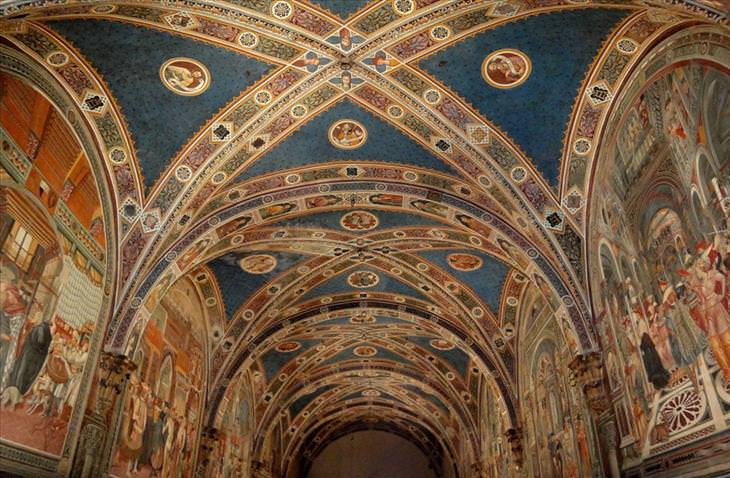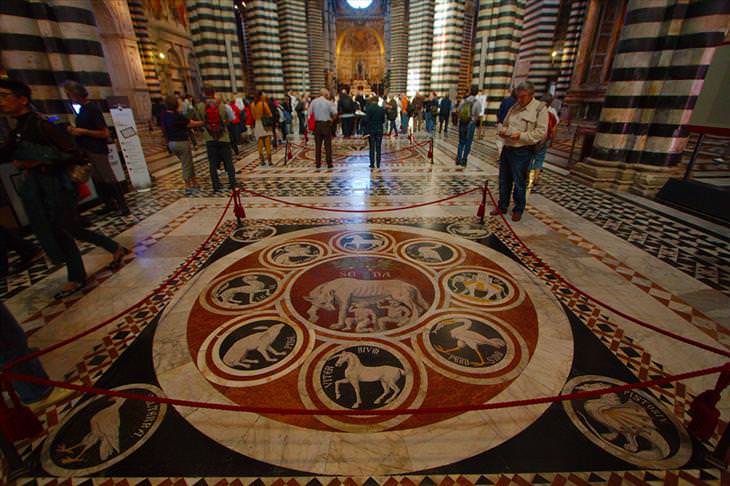 From the street, Santa Maria della Scala looks like just a simple building that used to be a hospital, but when you enter, an entire world of art from the best Italian artists is revealed. The building was built during the 12th century and was, in fact, one of the first hospitals in all of Europe. In this hospital, orphans were treated, the poor were fed and even temporary accommodation was offered to visitors. All this was possible due to wealthy people of Siena funding it. Today, this complex contains several exhibition halls of art and archeology and walls decorated with amazing frescoes.
From the street, Santa Maria della Scala looks like just a simple building that used to be a hospital, but when you enter, an entire world of art from the best Italian artists is revealed. The building was built during the 12th century and was, in fact, one of the first hospitals in all of Europe. In this hospital, orphans were treated, the poor were fed and even temporary accommodation was offered to visitors. All this was possible due to wealthy people of Siena funding it. Today, this complex contains several exhibition halls of art and archeology and walls decorated with amazing frescoes. 
Over the years, this church suffered heavy damage in the wake of the fires and earthquakes that occurred in the area, yet many parts of the roof and supporting pillars of the building remained intact till 1212. San Domenico is sometimes referred to as the " St. Catherine” after a nun who had lived in it the past. It is said that her head and thumb are still kept in the church in a gold container, while the rest of her body was laid to rest in Rome. In one part of the church there is a portrait of her, and in another, there is a series of paintings of her life story.
The National Museum of Siena is located within 2 ancient palaces filled with works of art that very much suit them. It is one of the most important museums in all of Italy, and inside it there are some of the greatest works of art of the Italian people from the 13th to the 17th centuries - the most famous of which are paintings from the 14th and 15th centuries, which were painted on gilded backgrounds.
This amazing fountain has a name that really befits it, since the word "Gaia" means "fun." The fountain was built in the middle of the 14th century with water pipes that run through 24 km to it, and the wolves symbolize Remus and Romulus, the twin brothers who, according to Roman mythology, founded the city of Rome.
Even after 700 years, the Palazzo Pubblico still serves its original purpose: to serve as the seat of Siena’s government. This building was built in Gothic style and originally held meetings of 9 people, each of which was replaced by participants from the middle class of Siena every two months. You can visit the conference room, as well as a civic museum, found inside the building which holds magnificent murals depicting the history of Siena.
This building began its life as a cathedral, but its construction was halted due to the Black Death epidemic of 1348. Today it is used as a museum of Christian art, and inside it are carved sculptures created by the architect of the building. The museum also has impressive works by Donatello and other Italian artists. If you climb to its top you can enjoy impressive panoramic views of Siena.
The interior of this 14th-century Gothic church is astonishing to anyone who sees it, and it is considered a complete artistic creation of the Renaissance. Around the fountain in the center of the building is the story of the life of John the Baptist, and there are frescoes made by the best artists of Siena, including Donatello, Lorenzo Ghiberti, and Jacopo della Quercia, who also designed the fountain itself.
The tower of Mangia rises above all other structures in Siena, except for one - Siena Cathedral. It is located next to the town hall and is built at the same height as Siena Cathedral to symbolize that the state and church are equally powerful. The construction lasted about 10 years, from 1338, and at that time it was the second tallest building in all of Italy. You can take the 400 steps up to 102 meters and get a magnificent view of Siena.
People visit the Piccolomini Library not to read ancient books, but to stare at the impressive interior design of the building, built in the 16th century. The library is located in the Cathedral of Siena and was built for Pope Pius II, whose nephew was responsible for its construction. He also chose the paintings that decorate its walls - describing the life of Pius II from his time as an ambassador, through his service as Cardinal to when he became the Pope.
10. The Palio di Siena
In this case, this is not a place, but a famous horse race that attracts a large crowd every year. This race has religious significance, and it passes through the streets of central Siena, which are covered in ash especially for this race. It takes place twice a year and dates back to the 16th century, when competitors used to compete on donkeys and buffalo. The races take place on July 2 and August 16, and sometimes, yet rarely, a third race takes place sometime during the year.
This cathedral is a huge church that was built in 1245. In the 15th century, they wanted to expand it and make it larger than the Basilica of St. Peter in Rome, but the Plague thwarted these plans. The incomplete walls of the cathedral are a reminder of this, with all the rest of it serving as a great example of Gothic architecture - from the bare posts that hold the ceiling to the specially designed tiles that shape the floors.
Piazza del Campo is the most recommended place to visit in Siena. It is located in the very heart of the historic center of the city and is considered one of the squares that most authentically reflects the medieval period throughout Italy. Most of the sites on this list surround the square, and the high standards for building in the area can be seen as early as the 13th century, which helped preserve it as it is today.

 From the street, Santa Maria della Scala looks like just a simple building that used to be a hospital, but when you enter, an entire world of art from the best Italian artists is revealed. The building was built during the 12th century and was, in fact, one of the first hospitals in all of Europe. In this hospital, orphans were treated, the poor were fed and even temporary accommodation was offered to visitors. All this was possible due to wealthy people of Siena funding it. Today, this complex contains several exhibition halls of art and archeology and walls decorated with amazing frescoes.
From the street, Santa Maria della Scala looks like just a simple building that used to be a hospital, but when you enter, an entire world of art from the best Italian artists is revealed. The building was built during the 12th century and was, in fact, one of the first hospitals in all of Europe. In this hospital, orphans were treated, the poor were fed and even temporary accommodation was offered to visitors. All this was possible due to wealthy people of Siena funding it. Today, this complex contains several exhibition halls of art and archeology and walls decorated with amazing frescoes.